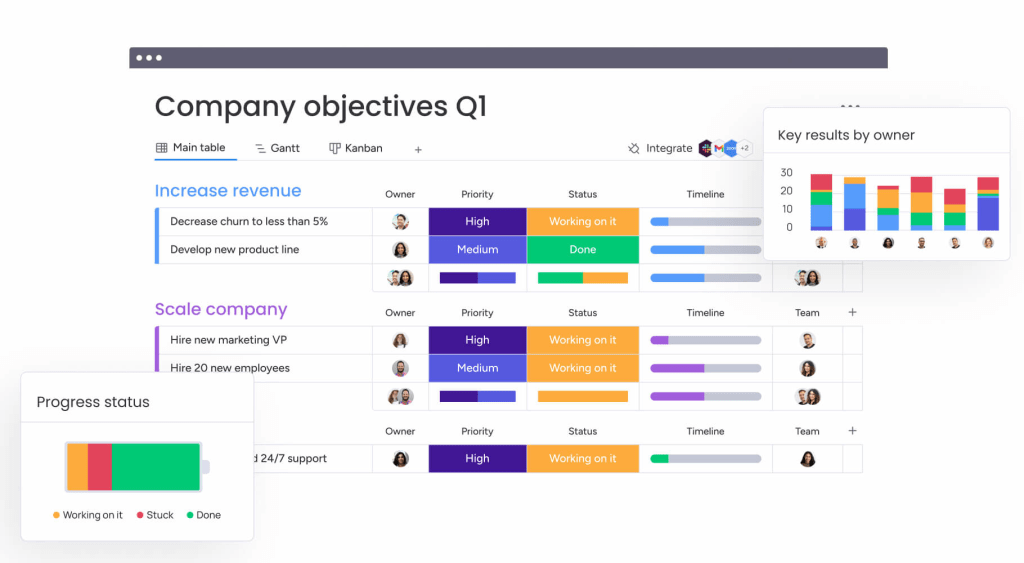

Alicia Schneider • Updated on Aug 25, 2024 • 12 min read
Link Copied!If keeping projects on track was easy, there wouldn’t be a whole field of project management dedicated to it. Every project needs to have a system in place to monitor and evaluate its progress and put it back on track when plans start to veer.
Project monitoring is a process within project management that allows you to check in on progress and find a path to make meaningful changes wherever necessary. Project monitoring is another phase of project management, and is just as important as all the other stages.
In this blog post, we’ll look at what makes project monitoring so important, its different substages, best practices, and how platforms like monday.com help project managers with all the heavy lifting.

Project monitoring is one of the key steps of the project management process, which includes initiation, planning, executing, monitoring and controlling, and closing. In the project monitoring stage, teams track a project’s progress by looking at different metrics that could affect a project’s outcome, such as:
Essentially, at this stage of the project management process, a project manager or other stakeholder is measuring a project’s current performance against the project plan and overall goals and identifying potential risks to project performance. If you’re not hitting milestones (e.g., delivering a prototype within a specified time), the project has a high chance of failure. This stage is essential to identifying additional roadblocks that could affect a project’s outcome.
Project monitoring involves tracking a project’s metrics, progress and associated tasks, making sure that everything is completed on time, within the project budget, and according to project requirements and standards. It’s also making sure that work doesn’t go beyond the initial project scope.
Pro tip: want to automate your monitoring and keep everyone on track? You need a project management software like monday.com work management to get it all done seamlessly.
Project evaluation works alongside project monitoring, and while they have similar goals, their processes are a little different. With project monitoring, managers may look at a project’s progress compared to initial project goals. However, in the project evaluation portion of this stage, they’d take factors like feedback and data collected in the monitoring stage to evaluate why a project is veering off its course, scope, or budget.
In the evaluation part, you’d look at the information gathered from monitoring and making decisions based on it. For example, taking scope creep into consideration, you can consider whether you need to adjust schedules or fast-track certain processes to meet deadlines.
The evaluation process happens throughout the project, not only after project objectives are met. There may also be more in-depth evaluations at big milestones, like the retrospective at the end of a sprint.
Finally, as the last piece of the puzzle, project control is about implementing corrective action to keep a project on track, in scope, and on budget while still maintaining high quality.
In this part of the project monitoring stage, you might want to take action such as:
Project control acts as the final substage of monitoring a project, where after you’ve collected data and evaluated how to make changes, you finally put your findings to work by making tangible changes to your project method, strategies, and course of action.
Companies waste an average of 5.2% of their investment on projects due to poor performance. Project monitoring, evaluation, and control act as three sides to the same tool that can be used to help you improve a project’s overall efficiency by catching and resolving issues before it’s too late.
In this stage of project monitoring, broken down into further substages, it’s clear to see how this process can benefit a project overall and better lead to successful outcomes. Project monitoring, evaluation, and control are essential aspects of project management for a few reasons:
After getting a better idea of what project monitoring entails, it’s important to implement your unique monitoring process with certain best practices in mind. While every team and company’s project monitoring process will look different, if you follow these tips, you’ll be able to get the most out of it and ensure the continued success of your project.
From the start of your project, you always want to clearly outline project goals as well as expectations on the team and individual levels. Establish what you expect from everyone on your team and make sure each member knows how to clearly communicate their updates or roadblocks when they’re not meeting deadlines so that the monitoring process goes more smoothly. You should also decide on mitigation strategies for every kind of scenario if you encounter potential issues or project risks throughout the project lifecycle.
While you should be using project management tools throughout an entire project, they become particularly helpful during the monitoring process. An all-encompassing project monitoring tool like monday.com will help you streamline workflows like data and feedback collection, allow you to gather reports on performance and key metrics, and let you view team workloads to better assess where your project is and what needs to be changed or fixed.
Pro tip: you can also use monday.com to see your data and project progress using different views such as the calendar view, or a kanban board view, chart view, or timeline view.
While the process of monitoring, evaluating, and controlling a project may lie with the project manager, it’s a lot easier on the person in charge when there’s effective communication throughout a project’s lifecycle. Getting regular updates from team members and key stakeholders on deliverables, roadblocks, feedback, and timelines allows you to monitor progress on an ongoing basis without having to constantly request new information.
Some projects may benefit from regular monitoring on an ongoing basis, while others may only need to go through this process once or twice. Consider how frequently you want to go through this entire process, whether weekly, monthly, or quarterly. You can also implement monitoring with every sprint or completed project phase instead of having it on a timeline.
Since project monitoring and evaluation rely on a lot of data that evaluate performance and progress, like key performance indicators (KPIs), use automation tools to help collect this information regularly. By having automated reports based on real-time information, you reduce the resources and time needed to manually gather this information. Software like monday.com allows you to automate reporting so that you can spend less time gathering data and more time analyzing and actioning it.
Monitoring a project is just one of the many things to do on a long list of project management tasks. However, like many other elements of project management, it’s an important step to ensure work is moving along smoothly. That said, monitoring a project can come with its own challenges along the way that can make it more difficult to accurately evaluate roadblocks and provide solutions. Let’s look at some of the most common challenges in project monitoring.
The best way to avoid these roadblocks and others is to prepare your project from the start, including making a plan for how you’ll continuously monitor it by setting clear objectives and trackable metrics. Additionally, using a platform that allows you to do everything in one place, like monday.com, will help you avoid the pitfalls of broken communication, manual reporting, and a lack of accurate data.
Project monitoring and evaluation enable you to make better decisions about ongoing and future projects, but without an all-encompassing platform like monday.com, it can be tricky to keep everything organized. monday.com helps teams and project managers organize data, track performance, follow project progress, and generate reports all in one place.
With easy-to-use automation, communication, and collaboration tools, you can rest assured that your entire project team can use one platform for multiple aspects of planning and executing a project. Here’s a closer look at some of monday.com’s features that make it ideal for project monitoring purposes.

Using a customizable dashboard, you can automatically generate reports and visual representations based on the data on your monday.com platform. Choose how you visualize data in your report with charts, timeline and schedule overviews, graphs, and widgets to see all your insights at a glance.

With over 27 different work views, you can choose how to best manage your project. The workload view allows you to quickly see which tasks employees are working on, how full their plates are, and what their workloads look like in the future. This allows you to more accurately assess performance, revise schedules, and allocate tasks based on available resources.

Implementing change that will positively affect your project is the goal of project monitoring, and monday.com makes that easy. With pre-made templates and boards to get started quickly, you can improve your team’s workflows with personalized automations to keep tasks moving quickly and multiple collaboration tools to make it easy to communicate, send and receive updates, and highlight the status of a task in real time.
Set expectations early:
Use project monitoring tools:
Encourage ongoing communication and feedback:
Decide monitoring frequency:
Automate data collection:
Use gathered data:
Identify causes of deviations:
Make informed decisions:
Implement corrective actions:
Ensure data accuracy:
Manage scope creep:
Address resource constraints:
Simplify reporting:
Improve communication:
Generate advanced reports:
Monitor workloads:
Improve workflow management:
By following this checklist, you can ensure effective project monitoring, evaluation, and control, leading to better project outcomes and optimized processes.
In a perfect world, all your projects would go according to plan. Everything would be completed on time and within budget, but that’s not always the reality. Employees may miss deadlines, external project stakeholders may back out, budgets can be exceeded, and project plans may not go smoothly.
Project monitoring and evaluation enables you to identify and mitigate issues that may impact the project scope, quality, timeline, or budget. You can then take those insights and use them to optimize processes for future projects. Using a platform like monday.com ensures that you have all the information you need at your fingertips to best monitor your project, evaluate where you’re at and what can be improved, and take control to steer a project back on course.

Alicia is an accomplished tech writer focused on SaaS, digital marketing, and AI. With nearly a decade of writing experience and a degree in English Literature and Creative Writing, she has a knack for turning complex jargon into engaging content that helps companies connect with audiences.
Don’t miss more quality content!